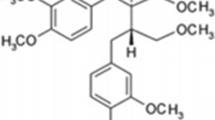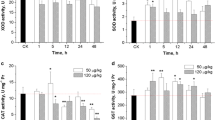Abstract
The aim of the present study was to investigate the protective effects and possible mechanism of phyllanthin against carbon tetrachloride (CCl4)-induced hepatic damage in common carp. Fish were fed diet containing four doses of phyllanthin (0, 100, 300, and 600 mg/kg diet) for 60 days, and then given an intraperitoneal injection of CCl4 (30 % in arachis oil) at a dose of 0.5 ml/kg body weight. At 72 h after CCl4 injection, blood and liver samples were collected for the analyses of serum biochemical parameters, peroxidation product, glutathione, and antioxidant enzyme activities. The results showed that administration of phyllanthin at the doses of 300 and 600 mg/kg in the diet prior to CCl4 intoxication considerably inhibited the adverse alterations caused by CCl4 in serum and liver tissue, including glutamate pyruvate transaminase, glutamate oxalate transaminase, lactate dehydrogenase, total protein, albumin, superoxide dismutase, glutathione peroxidase, catalase, glutathione, total antioxidant capacity and malondialdehyde. Furthermore, the positive effects of phyllanthin were confirmed in histopathologic examination. Overall results proved the hepatoprotection of phyllanthin, and it is suggested that phyllanthin may be used as a hepatoprotective agent to prevent liver diseases in fish.






Similar content being viewed by others
References
Ali SS, Kasoju N, Luthra A, Singh A, Sharanabasava H, Sahu A, Bora U (2008) Indian medicinal herbs as sources of antioxidants. Food Res Int 41:1–15
Banaee M, Sureda A, Mirvaghefi AR, Rafei GR (2011) Effects of long-term silymarin oral supplementation on the blood biochemical profile of rainbow trout (Oncorhynchus mykiss). Fish Physiol Biochem 37:885–896
Benzie IF, Strain J (1996) The ferric reducing ability of plasma (FRAP) as a measure of “antioxidant power”: the FRAP assay. Anal Biochem 239:70–76
Bhadauria M et al (2009) Emodin reverses CCl4 induced hepatic cytochrome P450 (CYP) enzymatic and ultrastructural changes: the in vivo evidence. Hepatol Res 39:290–300
Bhattacharya H, Zhang S, Xiao Q (2008) Comparison of histopathological alterations due to sublethal CCl4 on rosy barb (Puntius conchonius) and amphioxus (Branchiostoma belcheri) with implications of liver ontogeny. Toxicol Mech Methods 18:627–633
Bradford MM (1976) A rapid and sensitive method for the quantitation of microgram quantities of protein utilizing the principle of protein-dye binding. Anal Biochem 72:248–254
Cakmak I, Horst WJ (1991) Effect of aluminium on lipid peroxidation, superoxide dismutase, catalase, and peroxidase activities in root tips of soybean (Glycine max). Physiol Plant 83:463–468
Chandan B et al (2007) Hepatoprotective potential of Aloe barbadensis Mill. against carbon tetrachloride induced hepatotoxicity. J Ethnopharmacol 111:560–566
Cheng N, Ren N, Gao H, Lei X, Zheng J, Cao W (2012) Antioxidant and hepatoprotective effects of Schisandra chinensis pollen extract on CCl4-induced acute liver damage in mice. Food Chem Toxicol 23:1235–1241
Cheshchevik V, Lapshina E, Dremza I, Zabrodskaya S, Reiter R, Prokopchik N, Zavodnik I (2012) Rat liver mitochondrial damage under acute or chronic carbon tetrachloride-induced intoxication: protection by melatonin and cranberry flavonoids. Toxicol Appl Pharmacol 261:271–279
Ding L, Yongqing M, Fasheng C (1990) Nutritional lipid liver disease of grass carp Ctenopharyngodon idullus (C. et V.). Chin J Oceanol Limnol 8:363–373
Hernandez-Munoz R et al (1997) Balance between oxidative damage and proliferative potential in an experimental rat model of CCl4–induced cirrhosis: protective role of adenosine administration. Hepatology 26:1100–1110
Huang G-J et al (2013) Hepatoprotective effects of eburicoic acid and dehydroeburicoic acid from Antrodia camphorata in a mouse model of acute hepatic injury. Food Chem 141:3020–3027
Jia R, Cao L, Du J, Xu P, Jeney G, Yin G (2013) The protective effect of silymarin on the carbon tetrachloride (CCl4)-induced liver injury in common carp (Cyprinus carpio). In Vitro Cell Dev Biol Anim 49:155–161
Kandhare AD, Ghosh P, Ghule AE, Zambare GN, Bodhankar SL (2013) Protective effect of Phyllanthus amarus by modulation of endogenous biomarkers and DNA damage in acetic acid induced ulcerative colitis: role of phyllanthin and hypophyllanthin. Apollo Med 10:87–97
Kepekçi RA, Polat S, Çelik A, Bayat N, Saygideger SD (2013) Protective effect of Spirulina platensis enriched in phenolic compounds against hepatotoxicity induced by CCl4. Food Chem 141:1972–1979
Krasnov A, Koskinen H, Rexroad C, Afanasyev S, Mölsä H, Oikari A (2005) Transcriptome responses to carbon tetrachloride and pyrene in the kidney and liver of juvenile rainbow trout (Oncorhynchus mykiss). Aquat Toxicol 74:70–81
Krithika R, Mohankumar R, Verma RJ, Shrivastav PS, Mohamad IL, Gunasekaran P, Narasimhan S (2009) Isolation, characterization and antioxidative effect of phyllanthin against CCl4-induced toxicity in HepG2 cell line. Chem Biol Interact 181:351–358
Krithika R, Verma RJ, Shrivastav PS, Suguna L (2011) Phyllanthin of standardized phyllanthus amarus extract attenuates liver oxidative stress in mice and exerts cytoprotective activity on human hepatoma cell line. J Clin Exper Hepatol 1:57–67
Lee C-Y, Peng W-H, Cheng H-Y, Chen F-N, Lai M-T, Chiu T-H (2006) Hepatoprotective effect of Phyllanthus in Taiwan on acute liver damage induced by carbon tetrachloride. Am J Chin Med 34:471–482
Lora J, Alonso FJ, Segura JA, Lobo C, Marquez J, Mates JM (2004) Antisense glutaminase inhibition decreases glutathione antioxidant capacity and increases apoptosis in Ehrlich ascitic tumour cells. Eur J Biochem 271:4298–4306
Malekinejad H, Alizadeh A, Cheraghi H, Meshkin S, Dardmeh F (2012) The protective effect of liquorice plant extract on CCl4-induced hepatotoxicity in common carp (Cyprinus carpio). Vet res forum 3:158–164
Malhi H, Gores GJ (2008) Cellular and molecular mechanisms of liver injury. Gastroenterology 134:1641–1654
Natsume M et al (1999) Attenuated liver fibrosis and depressed serum albumin levels in carbon tetrachloride-treated IL-6-deficient mice. J Leukoc Biol 66:601–608
Ohkawa H, Ohishi N, Yagi K (1979) Assay for lipid peroxides in animal tissues by thiobarbituric acid reaction. Anal Biochem 95:351–358
Okafor P, Ikpi M, Uwah I, Ebenso E, Ekpe U, Umoren S (2008) Inhibitory action of Phyllanthus amarus extracts on the corrosion of mild steel in acidic media. Corros Sci 50:2310–2317
Peskin AV, Winterbourn CC (2000) A microtiter plate assay for superoxide dismutase using a water-soluble tetrazolium salt (WST-1). Clin Chim Acta 293:157–166
Pfeifer KF, Weber LJ (1979) The effect of carbon tetrachloride on the total plasma protein concentration of rainbow trout, Salmo gairdneri. Compar Biochem Physiol Part C Compar Pharmacol 64:37–42
Pikarsky E et al (2004) Pathogenesis of acute viral disease induced in fish by carp interstitial nephritis and gill necrosis virus. J Virol 78:9544–9551
Rajeshkumar N, Joy K, Kuttan G, Ramsewak R, Nair MG, Kuttan R (2002) Antitumour and anticarcinogenic activity of Phyllanthus amarus extract. J Ethnopharmacol 81:17–22
Riordan SM et al (2003) Peripheral blood mononuclear cell expression of toll-like receptors and relation to cytokine levels in cirrhosis. Hepatology 37:1154–1164
Shaker ME, Zalata KR, Mehal WZ, Shiha GE, Ibrahim TM (2011) Comparison of imatinib, nilotinib and silymarin in the treatment of carbon tetrachloride-induced hepatic oxidative stress, injury and fibrosis. Toxicol Appl Pharmacol 252:165–175
Shivashri C, Rajarajeshwari T, Rajasekar P (2013) Hepatoprotective action of celery (Apium graveolens) leaves in acetaminophen-fed freshwater fish (Pangasius sutchi). Fish Physiol Biochem 39:1057–1069
Slater TF (1984) Free radical mechanisms in tissue injury. Biochem J 222:1–15
Weber LW, Boll M, Stampfl A (2003) Hepatotoxicity and mechanism of action of haloalkanes: carbon tetrachloride as a toxicological model. CRC Crit Rev Toxicol 33:105–136
Wolf JC, Wolfe MJ (2005) A brief overview of nonneoplastic hepatic toxicity in fish. Toxicol Pathol 33:75–85
Xia D, Fan Y, Zhang P, Fu Y, Ju M, Zhang X (2013) Protective effects of the flavonoid-rich fraction from rhizomes of Smilax glabra Roxb. on carbon tetrachloride-induced hepatotoxicity in rats. J Membr Biol 246:479–485
Yadav NP, Pal A, Shanker K, Bawankule DU, Gupta AK, Darokar MP, S Khanuja SP (2008) Synergistic effect of silymarin and standardized extract of Phyllanthus amarus against CCl4-induced hepatotoxicity in Rattus norvegicus. Phytomedicine 15:1053–1061
Yin GJ, Cao LP, Xu P, Jeney G, Nakao M, Lu CP (2011) Hepatoprotective and antioxidant effects of Glycyrrhiza glabra extract against carbon tetrachloride (CCl4)-induced hepatocyte damage in common carp (Cyprinus carpio). Fish Physiol Biochem 37:209–216. doi:10.1007/s10695-010-9436-1
Zeng T, Guo F-F, Zhang C-L, Zhao S, Dou D-D, Gao X-C, Xie K-Q (2008) The anti-fatty liver effects of garlic oil on acute ethanol-exposed mice. Chem Biol Interact 176:234–242
Acknowledgments
This work was supported by Central Public-interest Scientific Institution Basal Research Fund of China (2013 JBFM12), Jiangsu Science and Technology Department (BK2012535) and National Natural Science Foundation of China (31202002, 31200918).
Author information
Authors and Affiliations
Corresponding author
Additional information
Rui Jia and Jin-Liang Du have contributed equally to this work.
Rights and permissions
About this article
Cite this article
Jia, R., Du, JL., Cao, LP. et al. Hepatoprotective and antioxidant effects of phyllanthin against carbon tetrachloride-induced liver injury in Cyprinus carpio . Aquacult Int 23, 883–893 (2015). https://doi.org/10.1007/s10499-014-9847-6
Received:
Accepted:
Published:
Issue Date:
DOI: https://doi.org/10.1007/s10499-014-9847-6




